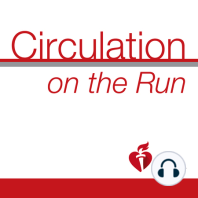20 min listen
Circulation August 14, 2018 Issue
ratings:
Length:
25 minutes
Released:
Aug 13, 2018
Format:
Podcast episode
Description
Dr Carolyn Lam: Welcome to Circulation on the Run, your weekly podcast summary and backstage pass to the journal and its editors. I'm Dr Carolyn Lam, Associate Editor from the National Heart Center and Duke National University of Singapore. I'm the one you usually hear chatting about all the papers in your weekly issue, however I am so delighted to be handing over the mic this week to two beloved colleagues, and they are Dr Greg Hundley and Dr Vlad Zaha, who will be taking us through this week's very special issue centered around cardio-oncology. Here they are. Dr Greg Hundley: My name is Greg Hundley. I'm a professor at VCU Health Sciences in Richmond, Virginia. We also have Vlad Zaha, who is an assistant professor at University of Texas Southwestern in Dallas. Dr Vlad Zaha: Hello, everybody. Dr Greg Hundley: We're going to be talking about the field of cardio-oncology today. As we all know, there have been many advances in the treatment of cancer lately, such that cancer is now becoming in some regards almost a manageable disease or a chronic disease for many individuals. But unfortunately we're seeing the emergence of cardiovascular disease in many patients, so much so that for some cancers, for example breast cancer survivors, cardiovascular events have supplanted the occurrence of cancer-related morbidity and mortality overall. And so emerging today is this new field of cardio-oncology, which is really a bridging discipline between oncologists and cardiologists that have been focused almost on examining the relationship between chemotherapies, radiation therapies, newer targeted immunologic therapies on the development of cardiovascular events. We as cardiovascular medicine specialists often become involved and then we are consulted to see a patient that might be scheduled to receive a cardiotoxic therapy and what should we do. Maybe they've already received, they're in the middle of the therapy, and we're asked to provide guidance to help the patient move through that therapy successfully. We're examining survivors now, those that have gone on the therapy and are experiencing increased cardiovascular risk. And then finally, a new emerging field that examines the association of risk factors that seem to be common between cancer and cardiovascular disease. In this issue of Circulation there are theories, really a miniseries of manuscripts, that are at this interface between cardiovascular and oncologic science and medicine. Following a similar miniseries that we published in 2015, this new block of manuscripts looks on some of the risk factors and mechanisms that may be common between these disorders. We're going to start today and look at this particular issue and examine the original manuscripts, look at the letters, and then talk a little bit about the review articles. I will walk through some of the introduction and then Vlad Zaha, who is working in cardio-oncology at University of Texas Southwestern, will help interpret for us some of the results and the meaning. The first study, an original manuscript by Simes et. al that's a subanalysis of the lipid study, and that's the Long-Term Intervention with Pravastatin in Ischemic Disease. The study is going to examine the relationship between D-dimer and the future development of cardiovascular events, but also importantly, cancer-related events. Remember, D-dimer is the degradation product of cross-linked fibrin markers of hypercoagulation and thrombosis. We use this a lot in the emergency department as an identifier of those at risk when we're suspecting one of CVT, pulmonary emboli, etc. This particular study focused on indi
Released:
Aug 13, 2018
Format:
Podcast episode
Titles in the series (100)
Circulation December 19/26, 2017 Issue: Circulation Weekly: Your Weekly Summary & Backstage Pass To The Journal by Circulation on the Run
